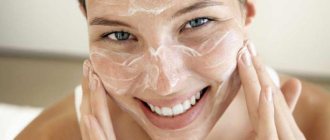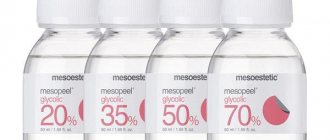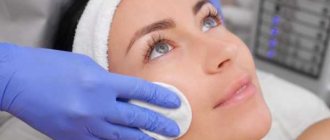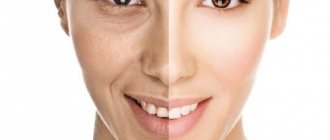No woman can be accused of wanting to look young and well-groomed at any age. That is why the desire to preserve youth for as long as possible is relevant at all times. In ancient times, women took baths with milk and made exotic facial masks. Currently, cosmetology has come to the fore, and it is developing at a breakneck pace, because even a circular facelift is a thing of the past. Today, beauties have adopted fractional rejuvenation of the face and neck.
Features of chemical peeling
If indicated, many dermatologists recommend cleaning the skin using special external products (creams, lotions, solutions, etc.). In cosmetology practice, the following substances are used to help exfoliate the skin:
- Phenol.
- Trichloroacetic acid.
- Alpha hydroxy acids (AHAs).
- Enzymes.
Each of the above reagents damages the skin to a different depth. Based on this, there are several types of chemical peeling:
- Surface.
- Median.
- Deep.
Superficial chemical peeling of the face removes the stratum corneum of the epidermis. Alpha hydroxy acids (30–70%) and trichloroacetic acid (15%) are commonly used for this procedure. Clinical experience shows that superficial facial peeling helps to slightly lighten the skin, reduce the appearance of small wrinkles and eliminate surface irregularities. Skin restoration after this type of cleansing occurs quite quickly. Almost immediately after the procedure is completed, you can use cosmetics and carry out your normal activities.
With medium chemical peeling, exfoliation of the stratum corneum and some part of the epidermis is observed. Trichloroacetic acid is used at a concentration of 20–35%. They may use a special Jessner solution, which is a combination of glycolic and trichloroacetic acids. After medium peeling, the skin is noticeably rejuvenated, with the disappearance of fine wrinkles, age spots and keratosis. The healing process takes about one week. At this time, there will be facial redness, some swelling and signs of peeling. Often, specific treatment is not required.
When performing a deep chemical peel, the lower layers of the epidermis are removed down to the dermis. Phenol is usually used as a cosmetic for this procedure. Deep facial cleansing can significantly rejuvenate and brighten the skin, smooth out most wrinkles, eliminate unevenness and keratosis. The recovery period takes about two to three weeks. There may be undesirable consequences from chemical peeling of the face, such as (hyperpigmentation, scar formation, etc.).
On the Internet you can find quite a lot of photos that will show what your face looks like after chemical peeling.
Phenol peeling
Chemical peeling using phenol should be carried out exclusively by a qualified specialist. In order to avoid the development of severe complications when performing this extremely serious cosmetic procedure, you must adhere to certain rules:
- Throughout the entire process of deep cleaning with phenol, the patient is under the control of a cardiac monitor that records the functional state of cardiac activity. In case of disturbances from the cardiovascular system, the procedure is quickly stopped.
- To reduce the concentration of phenol in the blood and speed up its removal from the body, the patient is asked to drink plenty of water before peeling.
- They adhere to a certain method of applying the active product, which exfoliates the deep layers of the skin. As a rule, the face is conventionally divided into four equal sectors. After treating one sector of the face, take a break for a quarter of an hour. Then they move to the next sector, etc.
- With this technique, phenol is absorbed into the body in small doses and has time to be destroyed by the liver.
- Be sure to warn the patient that after deep peeling, both light areas of the skin and areas of hyperpigmentation may remain, which will be almost impossible to get rid of.
In the vast majority of cases, phenol peeling is performed on a person once in a lifetime. It should be noted that the effect of this cosmetic event largely depends on the qualifications and experience of the specialist. The face either magically transforms, or the patient will significantly worsen his appearance and acquire a new cosmetic defect. Let's highlight the main side effects of phenol peeling:
- Rough scars.
- Discolored areas of skin.
- Areas of hyperpigmentation (darkening).
- Persistent redness of the skin.
- High sensitivity to ultraviolet radiation (refusal to tan).
Trichloroacetic acid
At first, trichloroacetic acid was used in dermatological practice for the treatment of various skin pathologies. Then it was discovered to have properties to eliminate aesthetic defects. Today, trichloroacetic acid is successfully used for superficial and mid-level cleansing of facial skin. At the same time, if used for deep peeling, the risk of developing various side effects is too high. The effect largely depends on the skill level of the specialist who performs this cosmetic manipulation.
At the present stage, gel-based products are used for trichloroacetic peeling. Their main advantages:
- The ability to evenly distribute the cosmetic product on the skin of the face.
- Absorption of trichloroacetic acid occurs more slowly and gradually.
- The procedure has become safer and more comfortable for patients.
- Unlike phenol skin cleansing, trichloroacetic peeling can be done more than once, and the interval between procedures should be at least a year.
- Repeated use of trichloroacetic peeling provides a significant improvement in the external condition of the skin. At the same time, the risks of complications are quite low.
When choosing the optimal method for cleansing your facial skin, you should be guided by expediency, and not by the influence of fashion trends.
Alpha hydroxy acids
More recently, dermatologists have turned their attention to alpha hydroxy acids (AHAs), which are organic acids found in many fruits. Depending on the concentration, solutions can affect both the outer stratum corneum and the epidermis and dermis.
The most popular alpha hydroxy acids, widely used in cosmetology:
- Glycolic. It is found in sugar cane and green grapes. Without much difficulty it penetrates into the thickness of the skin, providing a pronounced exfoliating effect. In addition, it exhibits whitening properties that help reduce hyperpigmentation.
- Dairy. Sources of this acid include milk, yogurt, blueberries, maple syrup, apples, tomato juice and other foods. It is characterized by exfoliating and moisturizing effects.
- Apple. Many fruits and fruits are rich in this acid, especially apples and tomatoes. In addition to exfoliating properties, it has a stimulating effect on cells due to the activation of local metabolism.
- Wine. Mostly present in grapes and aged wine. Effectively exfoliates, whitens and moisturizes the skin.
- Lemon. It can be found in most citrus fruits. The whitening effect is very pronounced. It also has antioxidant and antimicrobial properties.
It has been found that different concentrations of alpha hydroxy acids have different effects on the skin. High concentrations lead to desquamation of the epidermis, low concentrations stimulate cell renewal and help reduce the thickness of the stratum corneum. Facial cleansing using alpha hydroxy acids is considered the most gentle compared to other types of chemical peels. If low concentrations of acids are used, cleaning can be done regularly. Among the wide variety of these substances, glycolic acid is most often used.
The popularity of glycolic peeling is explained by the fact that despite high concentrations, a pronounced inflammatory reaction and prolonged redness of the skin are not observed, as with the use of trichloroacetic acid and phenol. However, quite often patients complain of burning and tingling.
Enzymatic peeling
It has been clinically proven that reduced activity of proteolytic enzymes in the skin slows down the renewal of the stratum corneum of the epidermis. As a result, dead horny scales accumulate on the surface of the face, giving the skin a dull gray appearance. Today, enzymes such as papain, subtilisin, etc. are used for enzymatic peeling. Many experts call it enzymatic exfoliation. The point is that the substances used ensure the removal of only the uppermost horny scales and protein contaminants from the skin of the face. If we take into account the depth of impact, then enzymatic peeling is very similar to modern cosmetic scrubs, which realize their cleansing effect only on the surface of the skin.
Contraindications for peeling
When should you not do a chemical peel? It is quite natural that not every patient can benefit from this cosmetic procedure. The following contraindications for peeling are identified:
- Periods of childbearing and breastfeeding.
- Acute stage of herpetic infection.
- Any infectious pathology (viral, bacterial, fungal).
- Heat.
- Open wounds in the area of peeling.
- Serious pathologies of the heart, kidneys, liver, circulatory system.
- Endocrine diseases (for example, diabetes mellitus).
- Oncological pathology (benign or malignant neoplasms).
- Allergy to substances and products that will be used to clean the skin.
Before using chemical peeling for the face, you need to familiarize yourself with the contraindications and possible side effects.
GENERAL PROHIBITIONS FOR EXFOLIATION: CHECK LIST
Universal advice that is usually given to those planning peeling: at least contact a cosmetologist-dermatologist for an initial consultation and exclude contraindications. Even a cursory professional assessment of the general situation will significantly save both time and money invested in a course of even home procedures.
At the same time, it is important to carefully select a clinic and a specific specialist based on reviews from real patients. After all, a non-professional may not take into account any contraindications for peeling, which will almost certainly lead to disastrous complications.
For example, doctors at the Herpes Clinic still talk about one of their patients on the sidelines. After peeling, she was forced to treat the consequences in the form of cheek dermatitis (rash and itching) for 8 months. The relapse of the disease occurred due to the girl’s predisposition to herpes infection: this factor was obviously not taken into account by the unqualified cosmetologist.
So, which groups of people should avoid peeling and why? Let's look at them in more detail.
Pregnant women
Concerns regarding peelings during pregnancy are associated with a number of factors:
- Firstly, the expectant mother is afraid of harming the baby.
- Secondly, it is very difficult to predict how the woman’s body will react.
Due to the restructuring of the endocrine system, even familiar and proven cosmetics can provoke redness and itching. What can we say about more toxic (for example, acidic) drugs.
Before and after chemical facial peeling
To remove the upper keratinized layer of the epidermis with alpha hydroxy acids, scrubs or enzyme preparations, no special skin preparation is required. However, the skin must be prepared for the use of more concentrated and aggressive exfoliants. Before cleansing, it is recommended to use bleaching agents that block the synthesis of melanin in skin cells, weak solutions of alpha hydroxy acids and retinoids. You should stop taking retinoids approximately 14 days before your procedure. Avoid prolonged exposure to the sun. Thanks to preliminary preparation:
- The synthesis of melanin in the skin is reduced, which makes it possible to reduce the likelihood of pigment spots occurring after chemical cleansing of the face.
- The skin texture is leveled, which allows the applied solution to evenly penetrate deep into the tissue.
- Regenerative mechanisms in the skin are activated.
Changes to the skin will depend on the type of chemical peel used. For example, after glycolic acid, the face usually becomes pink, rarely red. In some cases, the face appears somewhat swollen. However, this is considered a normal reaction to peeling. Medium and deep cleansing, as a rule, at first leads to the fact that the face acquires a white or yellowish tint. The face then becomes markedly red and swollen. The redness often goes away within a couple of days, but may persist for several weeks.
Also after the procedure, peeling of the skin is observed, which will be difficult to miss, especially with deep peeling. In addition, itching may occur. Sometimes you may even need medications to reduce it. During the first time after the procedure, you should regularly use external moisturizers and avoid prolonged exposure to the sun.
Reviews
“I have problem skin. For this type, TCA peeling is considered the most suitable. I got rid of the inflammation on my own, and decided to go to the salon to treat post-acne. I did 3 procedures with a break of 2 weeks. At the beginning of the session, they handed me a fan and began to apply the solution. After the first layer there were no sensations, but after the second the face began to simply burn. After each subsequent layer, the burning intensified; the fan did not help. This continued until a white coating appeared. Finally, they applied a leave-in neutralizing mask, which I went home with. On the third day, the skin began to peel off greatly and simply fall off in large pieces. This went on for five days. The results of chemical peeling can be seen after a month and a half. During this time, I already forgot what my face was like before the procedure. I evaluate the effect from the photos before and after the course. There is much less inflammation, the skin has become smoother, more even, and post-acne has also gotten rid of” - Olesya, 25 years old.
“I also did a medium chemical peel. In my opinion, the procedure is quite effective, but very painful. In addition, after it you need to apply Bepanten to your face for a long time. The disadvantages include the price. I paid 4,000 rubles for a session, but in some salons the cost reaches 9,000-10,000 rubles or even more. If you have the money, I recommend trying it. The face really looks younger, the skin is smoothed out, wrinkles are almost invisible. But you will have to endure the pain, and then the redness” - Yana, 37 years old.
“I do peeling at home. I use salicylic acid. The procedure is quite safe, does not cause discomfort, and helps well against excessive pigmentation and acne. A slight burning sensation may occur during peeling. It's quite normal. If irritation occurs, the solution must be neutralized immediately. After the procedure, the skin becomes dry and slightly tight. It must be constantly treated with moisturizer. The redness goes away quickly” - Ruslana, 28 years old.
During the procedure
Like any other cosmetic procedure, chemical facial peeling has its own application characteristics. Please note that it is better to entrust skin care to an experienced and qualified specialist. We list the main stages of the chemical peeling procedure for the face:
- Before applying an exfoliator, your face should be thoroughly cleansed. To do this, use a cleansing solution (for example, a special lotion), which ensures thorough removal of grease and dirt, but at the same time does not irritate or damage the skin.
- After applying the peeling product to your face, you may feel a slight burning and tingling sensation.
- Based on the condition of the skin, the specialist determines when the exfoliating agent needs to be removed.
- As a rule, the skin cleansing process lasts several minutes. It is worth noting that the duration of the procedure depends on the type of peeling (superficial, medium or deep) and the solution used.
- To remove the exfoliating agent, use warm water or a special neutralizing solution.
- Upon completion of the procedure, it is strongly recommended to use a protective cream with an ultraviolet filter.
If you do not know whether a chemical facial peel will help get rid of your skin pathology, consult your doctor for advice.
How dangerous is the procedure?
Information about the dangers of chemical peeling regularly appears in various medical and cosmetic sources. It is not known why, but most attention is paid to alpha hydroxy acids. There is an opinion that any cosmetic manipulations that promote exfoliation of the skin accelerate the aging process. But there is no confirmed clinical data regarding this theory.
The appearance of age spots is considered the most common consequence of chemical peeling of the face. After facial cleansing using chemical reagents, it is strongly recommended to avoid prolonged exposure to the sun. In addition, there is a high risk of bacterial infection, especially with deep peeling. If an infection develops, antibacterial drugs must be prescribed. It should be noted that in patients with fair skin, redness lasts for quite a long time (up to 70–90 days). In addition, with the depth of peeling, the likelihood of scarring on the skin increases.
Mechanism of action
Surface
Acids used in superficial chemical peeling of the face act on the stratum corneum of the epidermis, helping to reduce and smooth it. The skin becomes fresh, the dull complexion that the thickened stratum corneum gives it disappears. The effect on living cells accelerates their division and recovery. Fibroblasts located in the epidermis are stimulated, synthesizing elastin and collagen.
Median
Living skin cells are destroyed, while the formation of new cells that form the epidermis is accelerated.
At the same time, in the deep layers of the skin, the process of synthesis of elastin and collagen (they are responsible for skin elasticity) and the growth of new capillaries are accelerated and improved. The production of hyaluronic acid improves, thanks to which moisture is retained in the skin.
Deep
The mechanism of action of this procedure is based on the complete destruction of the surface layer and the effect on all layers of the skin. After peeling, the stratum corneum is completely absent. The process of its restoration and active synthesis of dermal structures begins. The result is completely renewed, almost new skin. The effectiveness of chemical facial peeling can be judged based on photographs of patients taken before the procedure and after the end of the recovery period.
results
What positive effects can be expected from chemical peeling? Along with the skill of the specialist and the individual characteristics of the skin, the results of facial cleansing also largely depend on the depth of exposure to the preparations. Expected effects:
- With superficial peeling, skin color improves, pigmentation decreases, and the severity of small wrinkles decreases.
- If you apply medium cleansing, the depth of wrinkles noticeably decreases, age spots disappear and complexion improves.
- After applying deep peeling, as a rule, small and medium wrinkles disappear, the skin is noticeably rejuvenated and whitened, and pigment spots disappear.
But chemical peeling cannot smooth out deep facial wrinkles, eliminate sagging skin and restore facial contour. It is also unable to restore the former elasticity and smoothness of the facial skin.
Selection of peeling
The first thing that is recommended for skin rejuvenation and elimination of minor defects on the face is chemical peeling. However, the question arises which type of procedure to choose in order to get the best effect with minimal side effects. First of all, it is necessary to take into account the condition of the skin and the severity of cosmetic defects.
If fine wrinkles and slight changes in pigmentation are noted and there are no signs of keratosis, the use of standard cosmetics and superficial peeling is indicated. In case of the appearance of the first pigment spots, initial signs of solar keratosis and facial wrinkles, it is recommended to turn to medium chemical and hardware peeling. If uneven pigmentation, spider veins, dilated capillaries, wrinkles “at rest” and solar keratosis are detected, they resort to using medium and deep peeling.
The ideal patient for chemical facial cleansing is considered to be a person who has symptoms of photoaging, but with minimal signs of stretching and sagging skin. Often, for maximum effect, they can combine various techniques for correcting the condition of the skin on the face. I would also like to note that the main indications for chemical peeling are acne scars, warts, pigmented areas and other superficial cosmetic defects that bring psychological discomfort to the patient.
Results
It is difficult to overestimate the positive effects of acids on the skin. However, if there is no urgent need for chemical exfoliation, it is better to replace this procedure with a more delicate retinoic or “yellow” cleansing. But if the decision has already been made, you need to go to a cosmetologist with extensive experience and knowledge in this field. Preliminarily study reviews of services, dermatologists, cosmetologists of beauty salons and clinics.
Chemical or physical peeling, contraindications for which must be taken into account before performing procedures, are non-invasive cosmetic techniques. Although the effect of them, and most importantly the rehabilitation period after some types of exfoliation, is comparable to skin restoration after plastic surgery or thread lifting. Provoking the destruction of the epidermal layers, many acid and hardware peels have a number of limitations for performing procedures that clients of cosmetology clinics and beauty salons need to be aware of.











